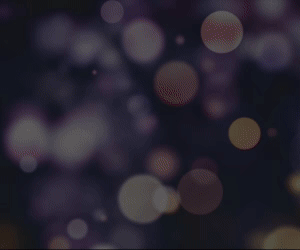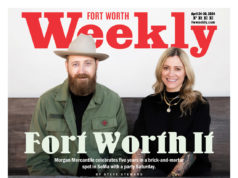Beneath the violet glow of dusk and across a dark, empty parking lot, a closed Costco megastore spills funnels of soft white light downward, creating angular, sinister shadows all around. Facing the building on horseback is a man in a brown cowboy hat, long-sleeved red shirt, blue jeans, and cowboy boots. Guess ol’ Sugarfoot will have to go without Beefaroni tonight, partner.
Hanging through the end of the month at the Fort Worth Community Arts Center as part of the 12th Annual Preservation Is the Art of the City, a juried show by Historic Fort Worth Inc., painter James Lassen’s “City of Cowboys and Pop Culture” works on several levels. It represents not only the overall timbre of the exhibit but also, in a weird, perhaps wholly unintended way, the spirit of contemporary Fort Worth.
You hear it every day: “Fort Worth, city of cowboys and culture.” Maybe you hear it more often than you’d like. For a lot of folks, the whole “cowboys” thing seems dubious. Sure, driving herds, ropin’ calves, and riding bucking broncs are part of our civic heritage, and we should be proud of our history. But c’mon. Do any occupational cowboys actually live here anymore? Is there even one square inch of Fort Worth that’s not paved over or burdened by offices, strip malls, and apartment complexes? The only seriously “cowboys” stuff we do that crosses over into the mainstream is host a stock show and rodeo once a year, slap longhorn logos on our police cars, and drive cattle beneath the shadow of Billy Bob’s Texas twice a day. By boasting that we’re all about “cowboys,” aren’t we being a little disingenuous?
More dubious is the brazen linkage between “cowboys” and “culture” itself. You don’t need to read a thousand-page scientific paper to know that people who enjoy ranch life and folks who skew more toward the arts exist on two wildly different sides of the political divide: most “cowboys” to the right, most “culture” lovers to the left. Claiming to cater to both equally threatens believability, especially when Tarrant County is well known as one of the most politically conservative regions in the state.
There’s just no getting around it, though. “Cowboys and culture” doesn’t seem to be going anywhere anytime soon. Might as well sit back and, as if on the velveteen back of a winged bull farting rainbows, try to enjoy the ride.
A good place to start is at the FWCAC. Yes, there are a lot of paintings of cowboys, Western gear, and livestock, but not all of them are inherently boring –– Patti Parrish’s portrait of a rooster, “Myrtle,” is spellbinding and, if exhibited out of context in some fancy New York City gallery, would go for way more than the $1,695 asking price, guaranteed. But no matter how well they’re executed, most artworks of cowboys, Western gear, and livestock do nothing to enlighten us or to further art, whose purest purpose is not to reinforce established beliefs but challenge them. There aren’t many people out there who love the Old West and also love superficially progressive art. They love the Old West and Old West art, much in the same way that progressive-minded folks tend toward superficially progressive art. Very few collectors and patrons ever cross over. Sad but true, and sloganeering cities shouldn’t pretend otherwise.
Not including the often stellar contributions from non-Fort Worth artists, Preservation Is the Art of the City should be required viewing for every loud and proud Fort Worthian. Simply put, we’ve got a lot of badass artists in our backyard.
Along with Lassen, contributor Devon Nowlin is a Visionary Artist. (Every year the Weekly honors three up-and-coming local artists in various disciplines as part of our Visionary Awards.) One of Nowlin’s paintings, the quirky “Wrapped Monument: Christo-Miró,” is part of Stories of the City, a small section of the exhibit devoted to artworks that deal specifically with the relationship between art and preservation. The piece is, simply, of Miró’s “Woman Addressing the Public,” the monumental primitivist and fertility-totem-inspired bronze sculpture that stands in front of the Kimbell Art Museum, wrapped in plastic. The covering was installed to protect the fantastical lady from damage during the repaving of the Kimbell’s driveway. “This act of care and preservation temporarily transformed the work and brought renewed attention to it as images of the wrapped monument were posted to social media,” Nowlin writes in the accompanying title card. “We saw it in a new way.”
The point of the exhibit is twofold: to help exceptional local artists sell work and to generate money for the preservation of “significant places and architecture throughout our city,” according to Historic Fort Worth Inc. Based on the number of red “sold” dots glowing from the title cards of dozens of pieces on display this year, Preservation Is the Art of the City is a huge success.
The badasses do not disappoint. Carol Benson, Janet Chaffee, Ann Ekstrom, F. David Gibson, John Hartley, Billy Hassell, Cindy Holt, Carol Ivey, Nancy Lamb, Julie Lazarus, John Carlisle Moore, and this year’s featured artist, Dennis Blagg, offer impressive work, work that, well, you can’t believe hadn’t sold already.
But the little-known commodities are just as impressive. Some of the most interesting pieces have a neon-’80s vibe. Bob Fox excels at silky pastel color fields, and Maryann Stephens’ rendition of the West 7th Street bridge celebrates the abstractness of the structure’s essence –– the canvas is dominated by a large hump in yellow, white, and red with lines crisscrossing elegantly beneath it on a milky blue background.
Easily the most intriguing piece in the exhibit is abstract painter Judy Mason-Eldridge’s “Statement of Justice,” a cartoonish and naïve art-influenced colored-pencil drawing of the Tarrant County Courthouse –– shiny, happy people flow in and out of the shaky-looking building. “The Tarrant County Courthouse was built to endure the passing of time,” the artist writes on the accompanying title card. “It presents … the gateway to the Stockyards that preserves those days of the Old West. … Stetson hats, cowboys, cowgirls, and cowboy boots everywhere. This is a lasting tradition.”
Really? If you say so.













Kudos Anthony, for your velveteen winged bull farting rainbows ride. That’s about perfect.
If anyone wants to see the “City of Cowboys and Pop Culture” painting described in the first half, here’s a link:
http://jameslassen.com/artwork/3593803_City_of_Cowboys_and_Pop_Culture.html